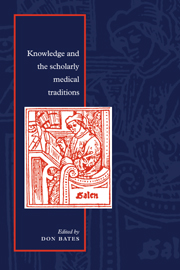Book contents
- Frontmatter
- Contents
- List of illustrations
- List of contributors
- Acknowledgements
- 1 Scholarly ways of knowing: an introduction
- Part 1 Scholarly medicine in the West
- Part 2 Chinese traditional medicine
- Part 3 Āyurvedic medicine
- 13 Writing the body and ruling the land: Western reflections on Chinese and Indian medicine
- 14 The scholar, the wise man, and universals: three aspects of Āyurvedic medicine
- 15 The epistemological carnival: meditations on disciplinary intentionality and Āyurveda
- Part 4 Commentaries
- Index
13 - Writing the body and ruling the land: Western reflections on Chinese and Indian medicine
Published online by Cambridge University Press: 01 February 2010
- Frontmatter
- Contents
- List of illustrations
- List of contributors
- Acknowledgements
- 1 Scholarly ways of knowing: an introduction
- Part 1 Scholarly medicine in the West
- Part 2 Chinese traditional medicine
- Part 3 Āyurvedic medicine
- 13 Writing the body and ruling the land: Western reflections on Chinese and Indian medicine
- 14 The scholar, the wise man, and universals: three aspects of Āyurvedic medicine
- 15 The epistemological carnival: meditations on disciplinary intentionality and Āyurveda
- Part 4 Commentaries
- Index
Summary
Like all history, this paper is fiction. It is not a lie, it is an honest account of things the author has seen. In the act of seeing, each seer creates an image; in the act of telling, each teller creates a story. As stories go, this is a bad one, being static and having no characters in it. The badness of this story is not my fault, it is the fault of the things I must look at (some texts) and the conventions I must follow (some rules) which preclude my making a really good story to put in this edited volume.
There were two main texts I looked at when I first composed my bad story. The first was a book by Paul Unschuld called Medicine in China. I employed it because I am ignorant of China and Unschuld's book was the most comprehensive scholarly work on the history of Chinese medicine accessible to me at the time. The second was a Master's thesis written some time ago by a graduate student in Chicago. I was that graduate student and therefore I know most of what is worth knowing about her. I know nothing about Paul Unschuld, and I hope he will forgive me for setting his book on a par with my first effort at interpreting Indian medicine.
These two texts – one and two decades old, respectively – remain the basis of my story. Any reader who would dismiss them as dated had better stop here, for we are talking in terms of millennia. Objections concerning interpretive styles, social and linguistic theories, and choice of translations may also be raised.
- Type
- Chapter
- Information
- Knowledge and the Scholarly Medical Traditions , pp. 279 - 296Publisher: Cambridge University PressPrint publication year: 1995
- 3
- Cited by

